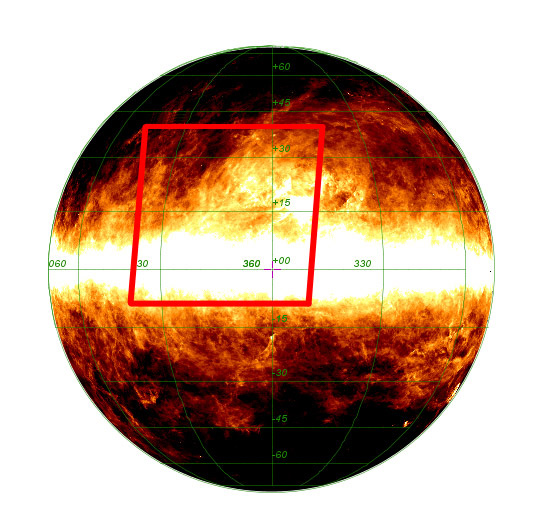Dust has never looked so beautiful! This new image from the Planck spacecraft shows giant filaments of cold dust stretching through our galaxy. The image spans about 50 degrees of the sky, showing our local neighborhood within approximately 500 light-years of the Sun. “What makes these structures have these particular shapes is not well understood,” says Jan Tauber, ESA Project Scientist for Planck. Analyzing these structures could help to determine the forces that shape our galaxy and trigger star formation.
What do these filamentary structures of dust represent? The denser parts are called molecular clouds while the more diffuse parts are ‘cirrus,’ and they do look like the wispy cirrus clouds we have on Earth. The local filaments are connected to the Milky Way, which is the pink horizontal feature near the bottom of the image. Here, the emission is coming from much further away, across the disc of our Galaxy.

The image has been color coded to discern different temperatures of dust. White-pink tones show dust of a few tens of degrees above absolute zero, whereas the deeper colors are dust at around –261°C, only about 12 degrees above absolute zero. The warmer dust is concentrated into the plane of the Galaxy whereas the dust suspended above and below is cooler.
Planck will help us study the biggest mysteries of cosmology, such as how the Universe and galaxies formed. This new image extends the range of its investigations into the cold dust structures of our own Galaxy.
Source: ESA

Our galaxy appears to be a regular fountain of dust!
Was all that dust created during the ‘Big Bang’? Or is it currently being created?
Very surreal, beautiful mix of colours. I wouldn’t mind having that on my wall somewhere =]
Nice to see Planck get some accolade This ESA spacecraft along with Herschel is doing some wonderful science,
Beautiful image.
Reminds me of the plasma crystal experiments.
😉
Wow, what an improvement in resolution over the older IRAS data mapped below. Interesting to see well known dark nebulae in emission! Just to the center-right of the top image (trailing eastward[left] of Antares) is the well-known dark nebula Barnard 44, continuing to the left to connect with the curved “bright” arc B 63. Nearby, the entire ‘Pipe Nebula’ (LDN 1773) is visible in emission! How many bright ‘dark nebulae’ can you see?
Of course, to Planck’s eyes, the cool cores of these dark dusty absorption nebulae glow brightly. Very interesting to see an ‘inverted’ image of these dark nebulae.
Plate 14 from Barnard’s “Photographic Atlas of Selected Regions of the Milky Way” has an excellent image of Barnard 44 (w-B 45 just above): http://www.library.gatech.edu/Barnard_Project_W/plate/Bar-pt1-pl014_sm.jpg scanned from the original plate!
BTW, Barnard’s entire atlas with introduction and great supplemental info can be accessed here: http://www.library.gatech.edu/search/digital_collections/barnard/index.html . I’m sure he would be pleased to see confirmation that his discoveries were actually obscuring dust (as seen in emission here by Planck) and not just starless ‘voids’ in the sky.
@Aqua
ALL matter in this universe originates in the big bang. What happen is that energy might be converted to matter and the reverse. But the matter+energy stays constant. Also the atoms gets an upgrade from Hydrogen to all other elements like metals and carbon in super nova.
Wow – stunning structure. I’ve looked forward to this mission for a long time, and it certainly isn’t disappointing.
solrey said;
“Beautiful image.
Reminds me of the plasma crystal experiments.”
Reminds me that people have go imaginations and like to have fanciful notions. Pity such “persona theories” ain’t science nor how science works.
Maybe, the dust is electrostatic too, and I know, the dust was created cause by cold fusion. How about galactic ice crystals frozen like on a window by some past interstellar ice age. Nah. Now who would believe nonsense like that?
Yo, gatekeeper crumb…honorable? Not!
Ignoring the poor grammar and spelling…
The Plasma Crystal experiments are conducted by the Max Planck Institute, most recently aboard the ISS. No “personal theories” or “fanciful notions” about it, just connecting the dots.
Yeah the dust would be electrostatic too. It’s a dusty plasma afterall.
I hope it makes you livid to be informed that there are folks at both ESA and NASA that are on board with EU theory and members of the forum.
Uh oh…EU is getting some attention while you’re drinking yourself into oblivion dude.
😉
solrey said;
“Yo, gatekeeper crumb…honorable? Not!”
Blah, blah , blah!
The only thing that is dishonourable is EU.
Its crap. You know it, and I know it.
@solrey
“I hope it makes you livid to be informed that there are folks at both ESA and NASA that are on board with EU theory”
Yeah you mean the cleaning lady and the garbage collector working at NASA and ESA?
“Yo, gatekeeper crumb…honorable? Not!”
Ah yes, “gatekeeper”, one of the EU promoter talking points. Insinuation of being repressed by the mainstream. Instead of looking at the problems of their favorite ideas, blaming others for repressing those ideas and preventing them from getting traction. Lovely.
“Planck, you sexy bastard!”
And to think that all that beauty is precisely ours to see, if Boussou (of the entropic principle) is correct.
Depends on how you define the big bang. If you define it as the overall expansion process, early on the matter content that “froze out” fused into nuclei up to lithium.
But none of that can aggregate, you need preferably silicon (common minerals) and carbon (organics) for that. Those elements were formed in suns and later released into space (part of solar wind and coronal emissions I believe, novas, supernovas).
Solar fusion giving energy results in nuclear isotopes up to various kinds of irons and some nickel, I believe. The rest of the atoms that can go into “dust” in minute amounts is created in supernovas and takes energy.